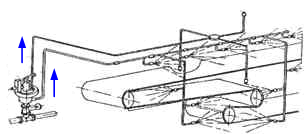 |
Pimachova Alla GrigorievnaFaculty:
"Heotechnologiy and control development" |
Topicality:
Development of fire-protection of mine workings equipped with belt conveyors is a topical scientific and technical problem. These roadways have high fire danger – combustible conveyor belt, wooden lining, mineral oil, electric cables. According to statistics every fifth exogenous fire takes place in belt conveyors. These fires are especially dangerous because they are spread quickly. This leads to huge material losses and deaths. During the last 10 years at belt conveyors only 20% of underground mines were put out at their initial stage.
Aim and tasks of the research:
To analyse the reasons of occurrence and development of exogenous fires at the mine of Ukraine. Grounding of fire-extinguishing installations in power-drive stations at mine "Krasnolimanskaya"
Scientific novelty:
According to research of SRI named after A.A.Skochinsky the reasons of exogenous fires are:
Practical value and realization of the received results:
At present most Ukrainian mines use belt conveyors to transport coal to insets. This tendency will grow in future. However use of conveyors increases significantly fire-load of mine roadways, thus increasing fire-risk.
At present most Ukrainian mines use belt conveyors to transport coal to insets. This tendency will grow in future. However use of conveyors increases significantly fire-load of mine roadways, thus increasing fire-risk.
Among the automatic means of fire-extinguishing the most popular is water fire-extinguishing installation (WFEI). It is produced in Ukraine in three variants. It is able to protect head sections of all kinds of belt conveyors.
At “Krasnolimanskaya” mine at each conveyor drive head there is WFEI, as it is most efficient to be used at head sections of belt conveyors with one or two conveyor head pulleys with the help of water ring, produced by the sprayed water.

General methods of research:
The following methods are used to develop theoretical ones, determine dependences defining basic parameters of fixed water-extinguishing installations, and to assess installations efficiency: mathematical statistics, theory of experimental design, modeling, mathematical analysis, classical physics, hydromechanics, aerodynamics, and theoretical mechanics.
Conclusion.
Patterns of water filling of step pipeline with uneven perforation and change of water flow speed at extinguishing installation starting have been defined analytically.
Practical value of the received results is that they are used as a base for calculating basic parameters of water fire-extinguishing installations and recommendations on their operational efficiency increase. Practical use of the method and recommendations will allow to develop new installations and modernize the present ones, which will provide efficient fire-protection in mine roadways with belt conveyors without reconstruction of the existing mine fire-irrigation pipelines.